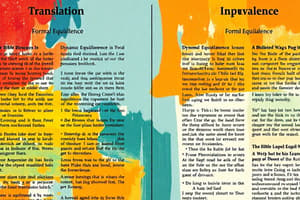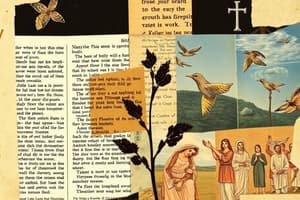Podcast
Questions and Answers
What major characteristic distinguishes Wycliffe’s Bible translations from earlier versions?
What major characteristic distinguishes Wycliffe’s Bible translations from earlier versions?
Wycliffe’s translations showed a strong adherence to the Latin word order, making them difficult for laypersons to understand.
What was Richard Rolle known for in relation to English religious works?
What was Richard Rolle known for in relation to English religious works?
Richard Rolle is known for writing an English Psalter and producing religious works focused on personal devotion.
How did the Tyndale Bible differ from its predecessors in terms of source material?
How did the Tyndale Bible differ from its predecessors in terms of source material?
The Tyndale Bible used Greek and Hebrew texts alongside Jerome’s Latin translation, unlike earlier versions.
What was a unique aspect of the Great Bible published in 1539?
What was a unique aspect of the Great Bible published in 1539?
What significant publication process did Tyndale utilize for his Bible translation?
What significant publication process did Tyndale utilize for his Bible translation?
Which Bible was notable for being the first English Bible divided into verses?
Which Bible was notable for being the first English Bible divided into verses?
In what time frame are early modern translations of the Bible typically categorized?
In what time frame are early modern translations of the Bible typically categorized?
What are the two notable versions of Wycliffe's Bible mentioned, and how do they differ?
What are the two notable versions of Wycliffe's Bible mentioned, and how do they differ?
How many languages was the Bible available in as of December 31, 2007?
How many languages was the Bible available in as of December 31, 2007?
What significant announcement did Wycliffe Bible translators make in 1999?
What significant announcement did Wycliffe Bible translators make in 1999?
Who started translating scripture into Old English toward the end of the seventh century?
Who started translating scripture into Old English toward the end of the seventh century?
What is the significance of the Lindisfarne Gospels?
What is the significance of the Lindisfarne Gospels?
Which dialect of Old English was used in the Wessex Gospels, and when were they produced?
Which dialect of Old English was used in the Wessex Gospels, and when were they produced?
What type of translations dominated the 11th century before more complete translations emerged?
What type of translations dominated the 11th century before more complete translations emerged?
Who translated much of the Old Testament into Old English in the 11th century?
Who translated much of the Old Testament into Old English in the 11th century?
What is the ormulum and in which language is it written?
What is the ormulum and in which language is it written?
What historical significance does the Douay-Rheims Bible have in terms of its completion?
What historical significance does the Douay-Rheims Bible have in terms of its completion?
How do modern English Bible translations differ in their manuscript sources compared to earlier versions?
How do modern English Bible translations differ in their manuscript sources compared to earlier versions?
What role do the Dead Sea Scrolls play in biblical translation efforts?
What role do the Dead Sea Scrolls play in biblical translation efforts?
What is one major controversy surrounding the Textus Receptus in relation to alternate texts?
What is one major controversy surrounding the Textus Receptus in relation to alternate texts?
Explain the concept of formal equivalence in biblical translation.
Explain the concept of formal equivalence in biblical translation.
What is indicated by the limited text notes in modern translations such as the New International Version?
What is indicated by the limited text notes in modern translations such as the New International Version?
How do the differences between the Nestle-Aland and Textus Receptus editions impact New Testament translations?
How do the differences between the Nestle-Aland and Textus Receptus editions impact New Testament translations?
Why is the documentation of differences in the Old Testament manuscripts considered less comprehensive?
Why is the documentation of differences in the Old Testament manuscripts considered less comprehensive?
What is the significance of the Preface to Fables in the context of translation and criticism?
What is the significance of the Preface to Fables in the context of translation and criticism?
How did Pope's translation of the Iliad influence perceptions of literary translation during his time?
How did Pope's translation of the Iliad influence perceptions of literary translation during his time?
What was Alexander Fraser Tytler's contribution to the field of translation theory in the 18th century?
What was Alexander Fraser Tytler's contribution to the field of translation theory in the 18th century?
What role did 18th century translators believe they had regarding the original works and contemporary readers?
What role did 18th century translators believe they had regarding the original works and contemporary readers?
What conflicting tendencies characterized translation practice in the 19th century?
What conflicting tendencies characterized translation practice in the 19th century?
Describe the approach translators took towards texts they found challenging or uninteresting in the 18th century.
Describe the approach translators took towards texts they found challenging or uninteresting in the 18th century.
Who were some prominent translators and critics in the 18th century besides Pope?
Who were some prominent translators and critics in the 18th century besides Pope?
How did British East India colonial administrators influence the translation of ancient Indian works in the 18th century?
How did British East India colonial administrators influence the translation of ancient Indian works in the 18th century?
What contribution did Edward Fitzgerald make to poetic translation in the 19th century?
What contribution did Edward Fitzgerald make to poetic translation in the 19th century?
How did Percy Bysshe Shelley approach his translation of Plato's dialogues?
How did Percy Bysshe Shelley approach his translation of Plato's dialogues?
What was Samuel Taylor Coleridge's notable translation work, and when was it published?
What was Samuel Taylor Coleridge's notable translation work, and when was it published?
Identify a significant 19th-century translation effort by Dante Gabriel Rossetti.
Identify a significant 19th-century translation effort by Dante Gabriel Rossetti.
What views did Friedrich Schleiermacher hold regarding the translation process during the 19th century?
What views did Friedrich Schleiermacher hold regarding the translation process during the 19th century?
How did Victorian translators differ in their approach compared to earlier figures like Dryden and Pope?
How did Victorian translators differ in their approach compared to earlier figures like Dryden and Pope?
What criticisms did Matthew Arnold face regarding his literal translation of Homer?
What criticisms did Matthew Arnold face regarding his literal translation of Homer?
What facilitated the translation of the Bible into various languages during the 19th century?
What facilitated the translation of the Bible into various languages during the 19th century?
Study Notes
Bible Translation History
- As of December 31, 2007, the Bible was available in 438 languages, including deuterocanonical texts, the Tanakh, and the New Testament.
- An additional 1,168 languages had the Tanakh or the New Testament, and portions of the Bible were accessible in another 848 languages, totaling 2,454 languages.
- Wycliffe Bible Translators launched Vision 2025 in 1999, emphasizing the significance of Bible translations.
Early English Translations
- The translation into English commenced around the 7th century with Venerable Bede and Aldhelm producing early scripture in Old English.
- The Lindisfarne Gospels (10th century) featured an Old English translation of the Gospels with glosses added by Aldred, representing the oldest known English Gospel translations.
- The Wessex Gospels were approximately 1,000 years old and marked the first complete translation of all four Gospels into English without Latin text.
11th Century and Glosses
- Abbot Aelfric translated much of the Old Testament into Old English, and translations often included extensive personal commentary rather than focusing solely on the biblical text.
- The Ormulum, a 12th-century Middle English text, included minimal Biblical content and mainly commentary, indicating a trend among early translators to personalize texts.
Wycliffe's Bible and Later Translations
- John Wycliffe's translation (14th century) introduced the Wycliffe Bible, which had two versions: an earlier one closely following Latin word order and a later, more understandable version.
- Early Modern English translations (1500-1800) marked a significant phase in English Bible translations with the introduction of the Tyndale Bible, which utilized the original Greek and Hebrew texts.
Major Early Modern Translations
- Tyndale's Bible was the first printed translation that circulated widely in England, leading to subsequent major translations such as the Great Bible (1539), the Geneva Bible (1560), and the Bishop's Bible (1568).
- The King James Version (1611) became a landmark translation style, along with the Douay-Rheims Bible, which incorporated all 14 books of the Apocrypha.
Manuscript Sources and Modern Translations
- Modern English translations are based on a variety of manuscripts, including the Septuagint, Textus Receptus, and Masoretic Text, enhanced by discoveries like the Dead Sea Scrolls.
- Controversy exists over which texts provide the most faithful translations due to differences in available manuscripts and textual variations.
Translation Techniques and Philosophy
- Modern translations employ various techniques, balancing between formal equivalence (literal translations prioritizing original meaning) and more accessible dynamic equivalence (focus on readability).
- Notable figures in translation during the 18th and 19th centuries included Pope, Dryden, and Tytler, each exploring different philosophies on the translator's role and the standard of translation.
19th Century Trends
- The 19th century saw a divergence in translation perceptions, either viewing translators as creative geniuses enriching literature or as mechanical relayers of meaning.
- Translation flourished, with significant works produced, such as Edward Fitzgerald's Rubaiyat of Omar Khayyam and various translations of German and Italian literature.
Cultural and Linguistic Impact
- British colonial interests fostered translations of the Bible into various languages, paving the way for the documentation of the languages and cultures within their colonies.
- The era was marked by experimental theories of translation, with a strong focus on fidelity to the original text while also considering the contemporary reader's experience.
Studying That Suits You
Use AI to generate personalized quizzes and flashcards to suit your learning preferences.
Related Documents
Description
Test your knowledge on the availability and translation of the Bible across various languages. This quiz covers statistics on deuterocanonical material, the Tanakh, and the New Testament. Discover the significance of these translations in the context of global access to biblical texts.




